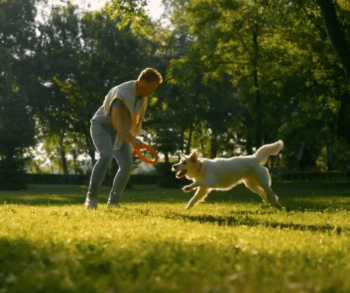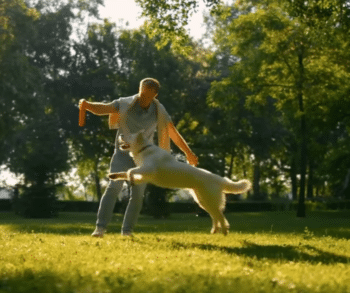When you encounter a dog adorned with red accessories, such as a collar, bandana, or leash, it’s important to recognize that this choice is far more than a simple fashion statement. The bold color red serves as a significant and intentional signal to anyone nearby, conveying a clear message: approach with caution. Much like a red traffic light instructs us to stop, a red accessory on a dog is a visual cue that the animal may require space, urging us to respect its boundaries and avoid any unsolicited interactions.
 Image Credit: YouTube
Image Credit: YouTubeThis color-coded system is more than just a visual cue; it’s a crucial part of communication between dogs and humans, designed to ensure the safety and comfort of both. While we often think of dogs as friendly, approachable companions, it’s important to remember that not every dog is open to interaction, even if their behavior might suggest otherwise. A wagging tail, for instance, does not always mean a dog is happy or willing to engage. The color red, therefore, serves as a universal signal to pause and assess the situation before approaching.
The choice of red for a dog’s accessories is not arbitrary. In the animal world, red is a color that demands attention and respect. It’s a visual reminder that the dog wearing it may need space, whether due to anxiety, fear, or even a tendency toward aggression. This is especially important in public settings where dogs might feel overwhelmed, nervous, or protective when away from their familiar home environment.
Dr. Brian Evans, a respected veterinarian, emphasizes the importance of understanding and respecting these visual cues. According to Dr. Evans, red accessories on a dog are a clear signal that the animal should not be approached without caution. Ignoring this signal can lead to stressful or even dangerous situations, both for the dog and the person trying to interact with it.
Dogs, like people, have unique personalities, and not all dogs are comfortable with strangers approaching them. For some dogs, the red collar might be a signal that they have had negative experiences in the past or that they are naturally wary of unfamiliar people and animals. For others, it might indicate that they are in training and need to remain focused, free from distractions.
While the color red is often associated with dogs that may exhibit aggressive or anxious behavior, it is also commonly used by service and working dogs. These dogs play essential roles in assisting people with disabilities, guiding the visually impaired, providing therapy, and even helping with search and rescue operations. For these working dogs, wearing red is a way to communicate that they are on duty and should not be disturbed.
Service dogs are trained to perform specific tasks, and any interruption can distract them from their duties, potentially endangering the person they are assisting. For this reason, many service dogs wear red vests or collars that explicitly state their working status, often accompanied by messages such as “Do Not Pet” or “Service Dog at Work.” These messages are polite but firm reminders that these dogs are performing vital tasks and should be allowed to do so without interference.
 Image Credit: YouTube
Image Credit: YouTubeIt’s important to recognize that service dogs are not just pets; they are highly trained professionals. Their red accessories are not just about signaling a need for space but also about ensuring that they can carry out their responsibilities effectively. This is why it’s crucial for the public to respect these boundaries and avoid interacting with service dogs while they are working.
The concept of using color-coded accessories to communicate a dog’s temperament or needs is becoming increasingly popular in certain professional circles, particularly in canine training and competition environments. In these settings, different colors are used to convey various messages about the dogs’ behavior and temperament, helping to create a safer and more controlled environment for both the dogs and the people around them.
For example, in canine scent work competitions, where dogs are trained to identify and locate specific scents, a red bandana or collar might be used to signal that the dog needs to be left alone to focus on its task. In these highly specialized environments, the use of color-coded accessories is a form of polite communication, ensuring that everyone involved understands and respects the needs of the dogs.
However, despite the growing awareness of this practice in professional settings, it remains less common among the general pet-owning population in the United States. Many dog owners are unaware of the significance of these color codes, which can lead to misunderstandings and potentially dangerous situations. This is why it’s essential to spread awareness about the meaning of color-coded dog accessories, particularly the color red, to ensure that everyone understands the importance of respecting a dog’s space.
One of the foundational rules of interacting with dogs, regardless of the color of their accessories, is to always seek the owner’s permission before initiating contact. This practice is not only a sign of respect but also a safety measure, ensuring that both the individual and the dog are comfortable with the interaction.
Every dog is different, and their owners are the best judges of how they will react to new people. By asking for permission, you acknowledge the owner’s insight into their pet’s comfort levels and preferences, which reduces the risk of misunderstandings or negative encounters. It also allows the owner to prepare their dog for the interaction, making the experience more positive for everyone involved.
Ignoring this step can lead to unintended consequences, especially if the dog is wearing a red collar or other red accessories. Dr. Evans strongly advises against attempting to “win over” a dog that is signaling a need for space, as such attempts are likely to be counterproductive. Dogs are highly sensitive to body language and can become anxious or defensive if they feel threatened or overwhelmed.
 Image Credit: YouTube
Image Credit: YouTubeWhile red is a common and widely recognized color for signaling a need for space, it’s not the only color used in the dog community to communicate different behavioral signals. The world of canine communication is diverse, with a variety of colors used to convey specific messages about a dog’s temperament and needs.
Yellow: This color typically indicates that a dog may be nervous, anxious, or unpredictable. Dogs wearing yellow accessories might need extra space and should be approached with caution. They might be shy, recovering from an injury, or in training, and it’s important to respect their need for distance.
Orange: Orange is often used to signal that a dog may not get along well with other dogs. If you see a dog wearing orange, it’s a good idea to keep your distance, especially if you have your own dog with you. This color is a polite request to avoid close encounters that could lead to stress or conflict.
Green: On the other end of the spectrum, green accessories usually indicate that a dog is friendly and approachable. Dogs wearing green are generally open to interaction with both humans and other animals. However, it’s still important to seek the owner’s permission before approaching.
Blue: Blue is commonly associated with service dogs, working dogs, or dogs in training. These dogs are performing important tasks and, much like professionals at work, should not be disturbed. The blue color serves as a gentle reminder to the public to allow these dedicated canines to proceed with their responsibilities without interference.
Understanding and respecting the color-coded communication system within the dog community is essential for both current and prospective dog owners. By familiarizing ourselves with these visual cues, we can ensure positive and respectful experiences for everyone involved, strengthening the bond between dogs and their human friends.
This awareness also promotes harmony and safety in interactions between dogs and humans, highlighting the importance of recognizing and adhering to the signals that our canine companions use to express their needs and boundaries. When we respect these signals, we contribute to a safer and more enjoyable environment for both dogs and people.
 Image Credit: YouTube
Image Credit: YouTubeDoctor Left Her Dog In a Storage Bin
Whether you’re a dog owner or simply someone who loves interacting with dogs, taking the time to learn about the meaning behind color-coded accessories can make a significant difference. It helps to prevent misunderstandings, reduce the risk of negative encounters, and ensure that all interactions are positive and respectful.
In a world where dogs are often seen as friendly and approachable, it’s easy to forget that not every dog is comfortable with strangers. The use of color-coded accessories, particularly the color red, is a simple yet effective way to communicate a dog’s needs and boundaries. By understanding and respecting these visual cues, we can create a safer and more harmonious environment for both dogs and people, ensuring that every interaction is a positive one. So, the next time you see a dog wearing a red collar, bandana, or leash, remember that it’s more than just a fashion choice—it’s a signal to pause, respect the dog’s space, and ensure a safe and enjoyable experience for all involved.
Click the video below to watch this incredible story!
Please ‘SHARE’ to pass on this story to a friend or family member

 1 week ago
8
1 week ago
8



















 English (US) ·
English (US) ·